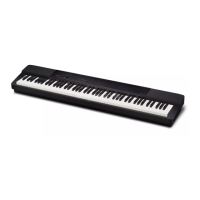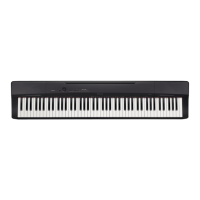8.15 Vibrato Delay (4EH)
Format
Message Format: BnH 4EH vvH
n: MIDI Channel Number
vv: Value (Note1)
Note1 : For information about the relationship between setting values and send/receive values, see 25.5 -64 - 0 - +63
Setting Value Table in VII Setting Values and Send/Receive Values of this document.
Send This message is not sent by this Instrument.
Receive Receipt changes the vibrato auto delay of the tone that is currently selected by the applicable
part.
8.16 Portamento Control (54H)
Format
Message Format: BnH 54H vvH
n: MIDI Channel Number
kk: Source Note Number
Send This message is not sent by this Instrument.
Receive Receipt of this message first stores the Source Note Number for the next note. When the
next Note On is received, the portamento effect is applied to the note using this Source Note Number as
the pitch start point and the Note On event key number as the end point. If there already is a note being
sounded by Source Note Number at this time, the new note on is not performed and the portamento
effect is applied to the pitch of the note being sounded. That is to say that legato play is performed.
8.17 High Resolution Velocity Prefix (58H)
Format
Message Format: BnH 58H vvH
n: MIDI Channel Number
vv: Value
Send Sends the lower seven bits of 14-bit Velocity when a key is pressed or released. (Note1)
Receive Receipt is handled, in combination with the following Note On/Off message, as the lower
seven bits of 14-bit Velocity. (Note1)
For information about the relationship between the Note On/Off message and High Resolution Ve-
locity Prefix message, see ”4.3 Instrument Velocity Resolution”.
17

